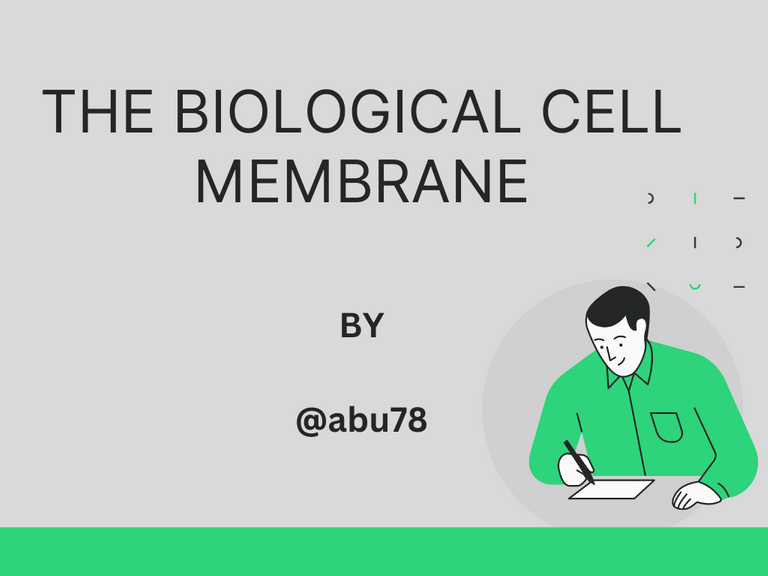The Biological cell membrane and the functions
Greetings everyone here once again, I am here again to write and share with you all my science-related articles again. Today I will be tackling the biological cell membranes and their functions. Without much ado, let's dive into the topic now.

Biological membranes are structures that separate cells from their environment. They are made of thin, flexible surfaces separating cell compartments from their surroundings. Membranes are composed of the following; proteins, lipids, and carbohydrates.
Types of membranes also include; cutaneous membranes, mucous membranes, serous membranes, and synovial membranes. Let's look at each of the components of membranes and what they are made up of.
Membrane Proteins are of two types and they include integral or intrinsic proteins and peripheral or extrinsic proteins.
Integral (Intrinsic) Proteins
The integral proteins are embedded in the hydrophobic core of the lipid bilayer which functions as transport and anchorage. A good example is transmembrane proteins being exposed on both sides of the membrane. The integral membrane functions as a transport system, and also has three main types of this transport system which include uniport, symport, and antiport.
With uniport, only a single molecule is transported through the membrane, whilst with symport and antiport, two different types of molecules are transported through the membrane. Just that their difference is the direction of movements of the two molecules. When the two molecules move in the same direction, it is termed a symport and when it moves in the opposite direction to each other it is termed an antiport.
Peripheral (Extrinsic) Proteins
Peripheral proteins are proteins that are covalently attached outside of the biological membrane. They sometimes penetrate the peripheral regions of the lipid bilayer or get attached to the integral proteins. Peripheral proteins are responsible for cell signaling and cell-to-cell interaction.
General Functions of Membrane Proteins
They serve as a source of transport
They play a vital role in enzyme activity
They also function in cell surface identity marker
They serve as attachments to the cytoskeleton
They serve as cell surface receptor
Finally, they play role in cell adhesion.
Now let's look at lipids as components of the membrane.
Lipids: they are amphipathic in biological membranes. The hydrophobic region of membranes is prevented from getting in touch with water through the aid of the orientation of the amphipathic nature of lipids. The major lipids that can be found in biological membranes include; phospholipids, glycolipids, and cholesterol.
Phospholipids are composed of two non-polar fatty acid chains (tails) and one polar group (head). The phospholipid molecules can be oriented to form different structures including lipid bilayer, liposome, and micelle.
Glycolipids on the other hand are also lipids of the membrane and they are formed within the plasma membrane. They are covalently attached outside making them become exposed to the outer surface of the cell. They play a vital role in cellular recognition and in communication.
Finally, cholesterol which is a steroid is also amphipathic in nature and plays a vital role in membranes. They include; the provision of stability to membranes, maintenance of fluidity, stronger bilayer, and flexible bilayer.
Carbohydrates
Carbohydrates are also one of the major components of biological membranes which are linked to proteins of lipids covalently. They play a vital role in cell-to-cell recognition and also serve as the basis for the rejection of foreign cells by the immune system of humans.
Let's look at another structure of the cell membrane called the glycocalyx. Glycocalyx is a carbohydrate coat that covers the surface of the cell membrane. Glycocalyx serves as the provision of attachment between cells and also serves as the provision of negative charge to the cell membrane.
General Function of the Cell Membrane
As we all know the basic function of the cell membrane is to protect the cell from its surroundings.
Cell membranes are permeable to ions and organic molecules. Cell membranes are also responsible for regulating substances in and out of the cells.
Membranes also play a vital role in the removal of waste products from cells.
Cell membranes also regulate cell growth by balancing endocytosis and exocytosis.
This is where I would end the membrane's topic. You can leave a comment in the comment section so we interact on this topic.
Thank you all for your time and attention.
The references given below are sites where you can learn more about the membranes topic.
Reference 1
Reference 2
Reference 3
Reference 4

Thanks for your contribution to the STEMsocial community. Feel free to join us on discord to get to know the rest of us!
Please consider delegating to the @stemsocial account (85% of the curation rewards are returned).
You may also include @stemsocial as a beneficiary of the rewards of this post to get a stronger support.
Interesting article, nicely written
Posted from HypeTurf
Thank you so much for complementing my article. I am glad you liked it.
Pleasure